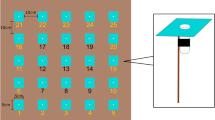Abstract
The honey bee dance language, used to recruit nestmates to food sources, is regarded by many as one of the most intriguing communication systems in animals. What were the ecological circumstances that favoured its evolution? We examined this question by creating experimental phenotypes in which the location information of the dances was obscured. Surprisingly, in two temperate habitats, these colonies performed only insignificantly worse than colonies which were able to communicate normally. However, foraging efficiency was substantially impaired in an Asian tropical forest following this manipulation. This indicates that dance language communication about food source locations may be important in some habitats, but not in others. Combining published data and our own, we assessed the clustering of bee forage sites in a variety of habitats by evaluating the bees’ dances. We found that the indicated sites are more clustered in tropical than in temperate habitats. This supports the hypothesis that in the context of foraging, the dance language is an adaptation to the particular habitats in which the honey bees evolved. We discuss our findings in relation to spatial aggregation patterns of floral food in temperate and tropical habitats.




Similar content being viewed by others
References
Appanah S (1990) Plant-pollinator interactions in Malaysian rain forests. In: Bawa KS, Hadley, M (eds) Reproductive ecology of tropical forest plants. Man and biosphere series, vol 7. UNESCO, Paris, pp 85–102
Beekman M, Ratnieks, FLW (2000) Long range foraging by the honey bee, Apis mellifera. Funct Ecol 14: 490–496
Chahal BS, Gatoria GS (1983) Import of Exotic Bees (Apis mellifera Linn.) and Spread of Bee Diseases? Indian Bee J 45:11–13
Clark DA (1994) Plant Demography. In: McDade LA, Bawa KS, Hespenheide HA, Hartshorn GS (eds) La Selva: ecology and natural history of a Neotropical rain forest. University of Chicago Press, Chicago, pp 90–105
Dornhaus A (2002) When do dances make a difference? Significance of honey bee recruitment depends on foraging distance. Entomol Gen 26:93–100
Dornhaus A, Chittka L (1999) Evolutionary origins of bee dances. Nature 401:38
Dyer FC, Seeley TD (1989) On the evolution of the dance language. Am Nat 133: 580–590
Esch H (1978) On the accuracy of the distance message in the dances of honey bees. J Comp Physiol 123:339–347
Esch H, Zhang S, Srinivasan M, Tautz, J (2001) Honey bee dances communicate distances measured by optic flow. Nature 411: 581–583
Frankie GW, Baker HG, Opler PA (1974) Comparative phenological studies of trees in tropical wet and dry forests in the lowlands of Costa Rica. J Ecol 62:881–919
Frisch K von (1967) The dance language and orientation of bees. Harvard University Press, Cambridge, Mass.
Gould JL (1974) Honey bee communication. Nature 252:300–301
Heinrich B (1976) Flowering phenologies: bog, woodland, and disturbed habitats. Ecology 57:890–899
Heinrich B (1979) Bumblebee economics. Harvard University Press, Cambridge, Mass.
Janzen DH (1971) Euglossine bees as long-distance pollinators of tropical plants. Science 171:203–205
Kirchner W, Grasser A (1998) The significance of odor cues and dance language information for the food search behavior of honey bees (Hymenoptera: Apidae). J Insect Behav 11:169–178
Kleber E (1935) Hat das Zeitgedächtnis der Bienen biologische Bedeutung? Z Vergl Physiol 22:221–262
Kress WJ, Beach JH (1994) Flowering plant reproductive systems. In: McDade LA, Bawa KS, Hespenheide HA, Hartshorn GS (eds) La Selva: ecology and natural history of a Neotropical rain forest. University of Chicago Press, Chicago, pp 161
Lindauer L, Kerr WE (1960) Communication between the workers of stingless bees. Bee World 41:29–71
Osborne JL, Williams IH (2001) Site constancy of bumble bees in an experimentally patchy habitat. Agric Ecosyst Environ 83:129–141
Polakoff LM (1998) Dancing bees and the language controversy. Integrative Biol 1: 187–194
Primack RB (1985) Longevity of individual flowers. Annu Rev Ecol Syst 16:15–37
Ruttner F (1987) The evolution of honey bees. In: Menzel R, Mercer A (eds) Neurobiology and behavior of honey bees. Springer, Berlin Heidelberg New York, pp 8–20
Ruttner F (1988) Biogeography and taxonomy of honey bees. Springer, Berlin Heidelberg New York
Schneider SS (1989) Spatial foraging patterns of the African honey bee Apis mellifera scutellata. J Insect Behav 2: 505–521
Seeley T (1995) The wisdom of the hive: the social physiology of honey bee colonies. Harvard University Press, Cambridge, Mass.
Sherman G, Visscher PK (2002) Honey bee colonies achieve fitness through dancing. Nature 419:920–922
Steffan-Dewenter I, Kuhn A (2003) Honey bee foraging in differentially structured landscapes Proc R Soc Lond B 270:569–575
Steffan-Dewenter I, Tscharntke T (2000) Resource overlap and possible competition between honey bees and wild bees in central Europe. Oecologia 122:288–296
Towne WF, Gould JL (1988) The spatial precision of the honey bees’ dance communication. J Insect Behav 1: 129–155
Vera F (1996) Grazing ecology and forest history Cambridge University Press, Cambridge, UK
Visscher PK, Seeley TD (1982) Foraging strategy of honey bee colonies in a temperate deciduous forest. Ecology 63:1790–1801
Waddington KD, Visscher PK, Herbert TJ, Richter MR (1994) Comparisons of forager distributions from matched honey bee colonies in suburban environments. Behav Ecol Sociobiol 35: 423–429
Weidenmüller A, Seeley TD (1999) Imprecision in waggle dances of the honey bee (Apis mellifera) for nearby food sources: error or adaptation? Behav Ecol Sociobiol 46:190–199
Wenner A (1967) Honeybees: do they use direction and distance information provided by their dancers? Science 158:1072–1077
Whitehead DR (1968) Wind pollination in the angiosperms: evolutionary and environmental considerations. Evolution 23:28–35
Acknowledgements
For help and discussions, we would like to thank R. Gadagkar, R. Sukumar, M.J. Verdu, A. Weidenmüller, H. Demmel, and J. Tautz. We would also like to thank two anonymous referees for their valuable comments. This project was funded by DFG grants SFB 554 and Ch147/3-1. The experiments comply with the laws of the countries in which they were performed.
Author information
Authors and Affiliations
Corresponding author
Additional information
Communicated by M. Giurfa
Rights and permissions
About this article
Cite this article
Dornhaus, A., Chittka, L. Why do honey bees dance?. Behav Ecol Sociobiol 55, 395–401 (2004). https://doi.org/10.1007/s00265-003-0726-9
Received:
Revised:
Accepted:
Published:
Issue Date:
DOI: https://doi.org/10.1007/s00265-003-0726-9




